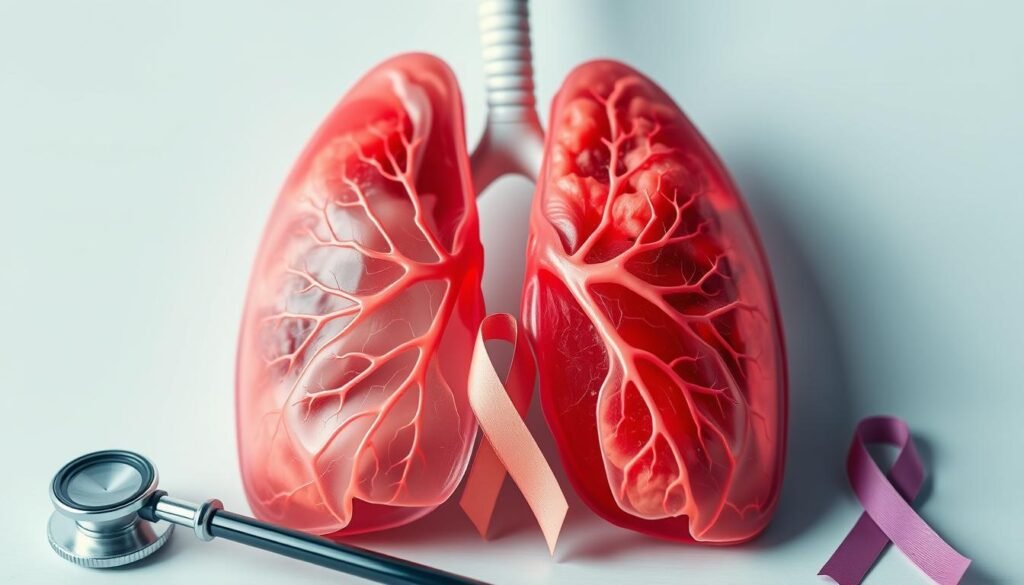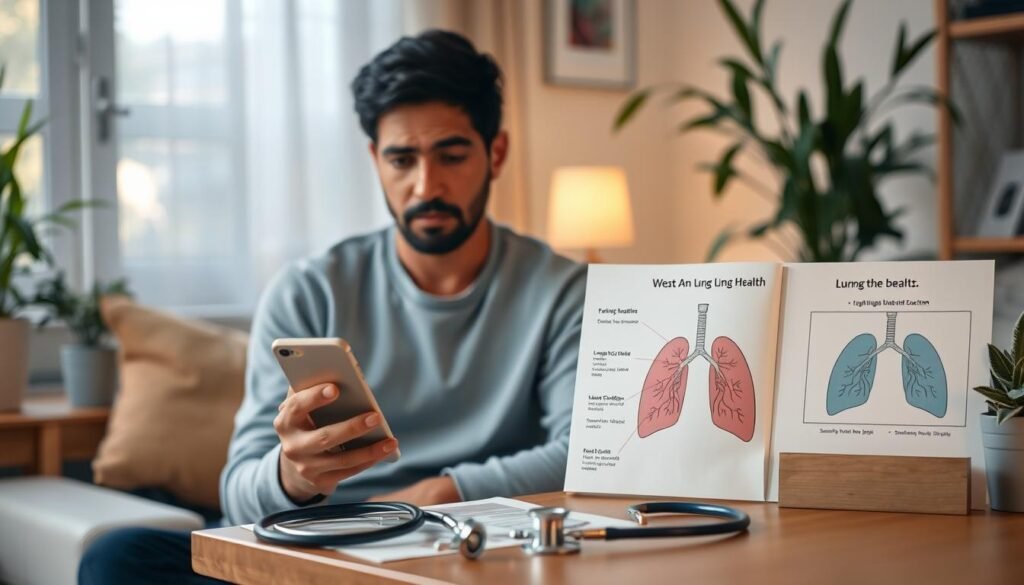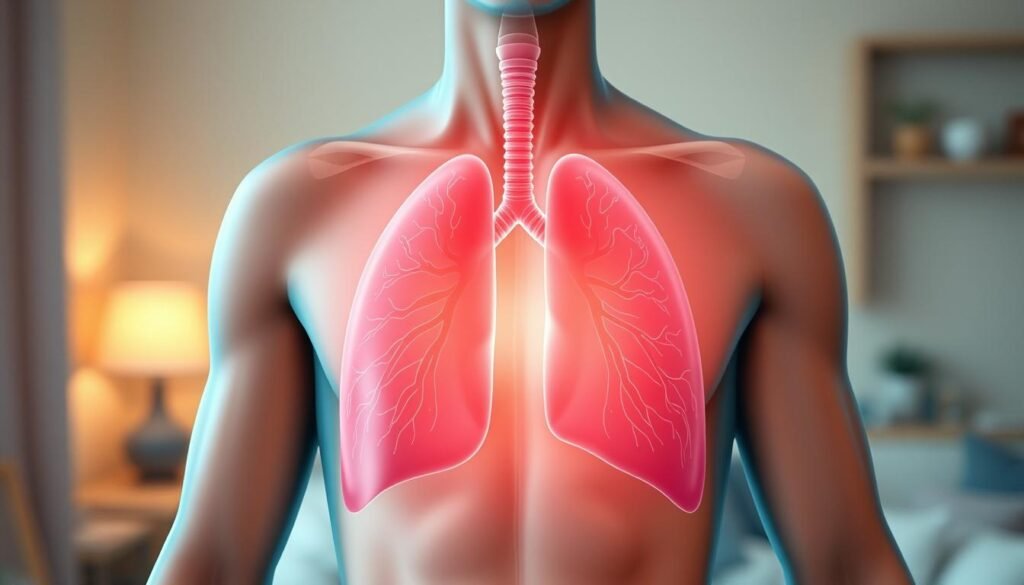Lung cancer is the number one cancer killer in the U.S. It takes more lives yearly than colon, breast, and prostate cancers combined. Over 150,000 people die from it each year. This makes the need for lung cancer early detection very important. It’s vital for those at higher risk to know the early signs and symptoms. However, at-home screening methods are not final diagnoses.
Learning to check for lung cancer at home can help people take action early. Spotting symptoms early can make treatments work better. But, experts say traditional tests like imaging and biopsies are needed for a true diagnosis.
Knowing the right information and using the right tools can improve lung cancer prevention efforts. It’s very important to watch out for your health. This means catching warning signs of lung cancer as soon as they appear.
Key Takeaways
- Lung cancer is the most deadly cancer in the U.S., exceeding deaths from other major cancers.
- Being educated on early symptoms can lead to better treatment results.
- Home screening for lung cancer is convenient but should be followed by professional testing.
- Awareness is key to improving survival rates and outcomes.
- Regular screenings are recommended for high-risk groups, particularly those with a significant smoking history.
Understanding Lung Cancer
Lung cancer starts when abnormal cells grow out of control in the lungs. It mainly comes from smoking a lot and breathing in pollutants. Knowing about different lung cancer types is key for a good lung cancer diagnosis.
There are two main kinds of lung cancer: NSCLC and SCLC. NSCLC includes subtypes like adenocarcinoma, squamous cell carcinoma, and large cell carcinoma. Each type has its own traits. SCLC is usually more fierce and linked with heavy smoking.
Finding out early signs of lung cancer types can change treatment results a lot. Knowing about it helps with early lung cancer diagnosis. This leads to better treatment soon. To learn more about lung cancer, check out this resource.
Common Symptoms of Lung Cancer
Lung cancer ranks as the second most common cancer in the United States. Many people don’t notice symptoms in the beginning. Catching lung cancer symptoms early improves treatment success greatly.
Persistent Coughing
A persistent cough that lasts more than eight weeks could mean lung cancer. This cough might change, raising red flags about your health. It may also involve coughing up blood.
Shortness of Breath
Shortness of breath is a sign when lung cancer gets worse. This happens when air passages narrow. It makes deep breathing or physical effort tough.
Chest Pain and Discomfort
Chest pain can vary in severity and happens during actions like coughing. It’s a sign of lung cancer that needs quick checking by doctors.
| Symptom | Description |
|---|---|
| Persistent Cough | A cough lasting over eight weeks, potentially changing in nature |
| Shortness of Breath | Difficulty breathing, particularly during physical exertion |
| Chest Pain | Discomfort when coughing, laughing, or breathing deeply |
| Coughing up Blood | Presence of blood in cough, serious sign requiring immediate investigation |
If you show these symptoms, please get medical advice. Early detection is key for better treatment results. Visit Mayo Clinic’s Lung Cancer Overview for more.
Lung Cancer Risk Factors
Understanding lung cancer risk factors is key to prevent it. It helps people act early to protect their health.
Smoking History
Tobacco use is the top cause of lung cancer. About 80% of lung cancer deaths are linked to it. People who have smoked for a long time are at very high risk. Even being around smoke can increase your risk. This shows why smoke-free places are crucial.
Environmental Exposure
Environmental factors are important in lung cancer risk too. Radon gas in homes causes about 30% of lung cancers in nonsmokers. Being around asbestos, especially at work, also raises your risk. Other work-related chemicals and arsenic add to this risk, especially for smokers.
Family History
Having a family history of lung cancer can double the risk. Knowing your family’s health history can alert you to your own risk. If many of your close relatives have had lung cancer, your own risk is higher. This makes it important to keep an eye on your health.
Importance of Early Detection
Understanding how vital early detection of lung cancer is can save lives. By catching lung cancer early, the chances of beating it go way up. Screening is key in cutting down how many people die from the disease, especially if they’re at high risk.
Impact on Prognosis
Finding lung cancer when it’s still at stage I improves chances of survival. Sadly, only 21% of cases are found this early. To help, the US Preventive Services Task Force suggests yearly screenings for those 50 to 80 who smoked a lot.
These screenings often use low-dose CT scans. They’re much better at spotting tumors early than old-school chest X-rays.
Current Research Findings
New research is always happening around how to screen for lung cancer. It shows that checking every year with low-dose CT scans cuts death rates by 20% in those at high risk. Not all insurance covers these screenings, but they’re crucial for catching the disease early.
Having the right facilities for these scans matters a lot. Also, patients and doctors should talk together to make the best screening plan for each person’s health.

How to Check for Lung Cancer at Home
Lung cancer awareness is rising. As a result, many are looking into home testing. They are interested in the Galleri test, an innovative home lung cancer test. It aims to find cancer signals before any symptoms show up.
Home Lung Cancer Tests
Home tests for lung cancer are becoming more popular. They offer a way for people to check their risk of having lung cancer. The Multicancer Early Detection (MCED) test is a key method. It looks for certain markers that suggest cancer, including lung cancer. But remember, these tests don’t take the place of a doctor’s advice.
Understanding MCED Tests
It’s important to understand what MCED tests do. They check your blood for genetic signs of cancer. But, their accuracy is still being studied by doctors. Issues like cost and whether you can get the test might affect your decision. They’re a good first step, but you should see a healthcare provider for a proper diagnosis and treatment plan. For more details on lung cancer screening, check out these guidelines.
At-Home Screening Limitations
At-home lung cancer screening is convenient. But it’s essential to know its big limitations. This knowledge helps you make smart choices about health.
False Positives and Overdiagnosis Risks
At-home lung cancer screening often has false positives. These mistakes can wrongly hint at cancer. This leads to anxiety and more tests. The stress and costs of extra tests can be high. Furthermore, some cancers found might not affect health if untouched. This fact might lead to unnecessary treatments for some people.
The Need for Professional Consultation
Limited by its nature, at-home screening means professional consultation is key. If your at-home test shows something odd, see a doctor. Doctors often suggest low-dose CT scans for those at higher risk. The US Preventive Services Task Force says people 50 to 80 who smoked a lot should get yearly scans. For best results, expert review is crucial. For more, see this resource.

Professional Lung Cancer Screening Methods
Lung cancer screening is key to finding the disease early and improving patient survival. Doctors use various methods to spot possible cancers before any symptoms show up. Through imaging and biopsies, they can accurately identify problems in the lungs. This allows them to plan the best treatment.
Imaging Techniques
For spotting lung cancer, imaging is very important. The top methods used are:
- Low-Dose Computed Tomography (LDCT): This is advised for 50 to 80 year-olds who smoked a lot. It’s good at finding lung cancer early. Studies show LDCT scans lower death rates in heavy smokers.
- Chest X-Rays: These are common but don’t greatly decrease deaths from lung cancer. They’re not as good as LDCT in finding early cancer.
- Sputum Cytology: This test looks at lung mucus. But, it hasn’t been great at spotting lung cancer early.
Biopsy Procedures
If there’s a chance of lung cancer, doctors do biopsy tests. They take samples from the lung to confirm the diagnosis. Knowing for sure what’s wrong helps decide the best treatment. The main biopsy types are:
- Needle Biopsy: A needle gets cells from the lung, often with help from imaging.
- Bronchoscopy: This uses a tube with a camera to look inside and take tissue samples.
- Surgical Biopsy: This deeper test is done if others don’t give clear results. It takes more tissue samples.
In short, lung cancer screenings use detailed imaging and biopsy tests to find cancer. Early detection and understanding risks help improve treatment success. This leads to better survival rates and quality of life for patients.
How to Self-Examine for Lung Cancer
Learning to self-examine for lung cancer is vital. It allows people to be proactive with their health. Catching lung cancer early can greatly improve treatment success. Home test kits are helpful tools in watching for lung cancer signs.
Recognizing Early Symptoms
Knowing early lung cancer signs starts with noticing changes in your body. Some early symptoms include:
- A persistent cough that does not go away or worsens over time
- Unexplained weight loss and fatigue
- Shortness of breath, even during regular activities
- Chest pain or discomfort that doesn’t have an obvious cause
- Coughing up blood or rust-colored sputum
By being alert to these symptoms, you can check yourself for lung cancer. This can lead to quicker doctor visits when needed.
Utilizing Home Test Kits
Home test kits are helpful for watching your lung health. These kits can highlight early symptoms or risk factors. When using these kits, you should:
- Follow the instructions carefully to ensure accurate results.
- Record any unusual findings and symptoms experienced during the examination.
- Seek a healthcare professional’s advice for further evaluation if any concerning symptoms arise.
Even though these kits don’t replace a doctor’s visit, they are useful. They encourage us to keep an eye on our lung health.

Lung Cancer Treatment Options
After being diagnosed with lung cancer, people begin a journey to understand their treatment options. The first steps include talks with doctors to figure out the stage of the cancer. This helps tailor options to their health needs.
First Steps After Diagnosis
Choosing the right treatment for lung cancer depends on several factors. These include the stage of the cancer and the patient’s overall health. The main treatment options are:
- Surgery: Often the primary option for early-stage lung cancer to remove tumors.
- Chemotherapy: Utilized to kill or halt the growth of cancer cells, especially in advanced stages.
- Radiation therapy: Focused on targeting cancerous cells, may be used alone or alongside other treatments.
- Targeted therapy: These therapies focus on particular cancer characteristics, offering personalized treatment.
- Immunotherapy: Aims to strengthen the body’s immune response against the cancer.
Support Resources
Getting emotional and psychological support is crucial for those fighting lung cancer. There are many resources available to help individuals and their families during this hard time. These resources are:
| Type of Resource | Description |
|---|---|
| Support Groups | Facilitated meetings allowing individuals to share experiences and coping strategies. |
| Counseling Services | Professional help focusing on emotional health and coping mechanisms. |
| Educational Materials | Resources to enhance understanding of lung cancer and its treatment options. |
| Online Communities | Virtual platforms for connection and shared experiences among patients. |
Conclusion
Lung cancer is a top cause of cancer deaths in the United States, taking over 361 lives every day. Knowing the symptoms like lasting coughs and weight loss matters a lot. Identifying it early can greatly improve survival chances, which shows why it’s key to keep an eye on one’s health and get professional advice. Being aware of lung cancer signs helps people to take early action for their health.
Thanks to medical progress, tools like low-dose computed tomography (LDCT) screenings can catch lung cancer early. These screenings might lower death rates by up to 20%, which is hopeful news. But, with only 16% of those at high risk screened last year, more people need to get screened. This is why knowing how to check for lung cancer at home is critical for lung health.
Combining self-checks with regular professional screenings can fight lung cancer more effectively. While most treatments can’t cure lung cancer, it’s vital to understand all the treatment options. From surgery to immunotherapy, there are paths to take. By pushing for regular check-ups and symptom awareness, folks have a fighting chance at early detection. This means potentially living longer and healthier.